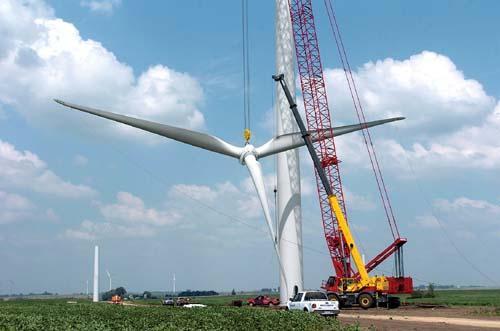

Share
Wind energy is a renewable resource with lucrative possibilities for Southern Minnesota. However, a study from the North Star Policy Institute shows that when wind farm developers don’t hire local workers, the community loses an estimated $30 to $40 million in economic benefits across seven major wind farm projects. Local workers will typically spend 95% of their income in the region where they live, whereas non-local workers typically take most of their earnings back home.
According to wind speed calculations Southwest Minnesota represents a particularly lucrative corridor for wind energy projects.


One such example of wind project hiring practices and their effect on the local economy was discussed during the Minnesota Public Utilities Commission (PUC) public hearing in Canby, MN in July, where attendees discussed the Bitter Root Wind Project. Renewable Energy Systems plans to erect 32 turbines for a total of 150 megawatt electrical production. Construction is scheduled to begin in 2019.
Executive Director of North Star Policy Institute Katie Hatt gave testimony comparing the effects on local economies of companies that hire locally versus non-locally.
Drawing her critique from North Star studies, Hatt commented that, “We expect Bitter Root to provide fewer local employment and economic benefits than the typical wind energy projects, so local workers and businesses may be better off if the project doesn’t go forward and potentially hinder the feasibility of a subsequent project or projects with stronger commitments to local hiring.”
Hatt notes that Minnesota’s wind energy economy is booming. In six years, power from wind energy has grown from 14 percent to 18 percent and is projected to continue increasing.
Hatt closed by stating that,
“Expanding wind energy in Minnesota brings a significant opportunity to invest in Minnesota workers and family-supporting construction jobs — for laborers, operating engineers, ironworkers and electricians. These jobs in turn will support Main Street businesses, additional jobs, and economic growth here in Yellow Medicine County and in communities throughout Southern Minnesota.”
A June report by North Star Policy Institute found that millions of dollars are at stake for Southern Minnesota communities. What determines the losses are whether new energy farm projects are built by local workers.
The report analyzes the potential local economic impacts of seven major wind farm projects that are seeking permits or in the pre-construction phase across Southern Minnesota.
The report finds that each wind energy construction job held by a local worker could bring on average $53,180 in direct wage and healthcare spending into local economies. Non-local workers are projected to spend less than a third of that amount, with spending estimations around $15,600. When retirement benefits are included, local workers are expected to contribute four times more to local economies than non-local workers, a projected $67,140.
Construction employment across all seven projects could generate between $42-$51 million in direct spending and $73 to $89 million in local economic activity if 50 to 70 percent of hours worked are local residents. Wind projects are expected to create more than 1,200 jobs during construction.
The report’s authors project that local communities could lose $18 million in direct spending and $32 million in economic activity if projects are largely built using non-local labor, losses which are predicted if local projects utilize only 10 to 30 percent local workers.
Mankato Building Trades President Stacy Karels has noticed that the wind industry has shifted away from hiring local residents.
“It seems like a few of our wind developers have forgotten that Southern Minnesota is home to one of the best wind construction workforces in the country. Our members who live in Marshall and Tracy and Pipestone and Worthington haven’t just been building wind projects safely, on time and on budget in Minnesota for more than twenty years. They’ve also been contributing to their communities through their paychecks, health and retirement benefits, and volunteer hours.”
The report offers three recommendations for state and local officials to maximize local employment and economic benefits including:
-
Secure specific commitments from developers and contractors to set local hiring goals for new wind farm projects during the project approvals process.
-
Require regular reporting by developers on their use of local workers.
-
Encourage collaboration with state-registered apprenticeship programs that can help recruit and train local workers in skills needed to build wind energy facilities.
The Wind Project’s analysis explains that the green job revolution extracts wealth from small communities when project hires are not local. The U.S. wind sector employed more than 100 thousand workers in 2016, and “wind turbine technician” is one of the fastest growing jobs in the last decade. Communities in Southern Minnesota struggle to recover from the recession; consequently, these projects are well positioned to maximize the local benefit of these short-term wind projects.

